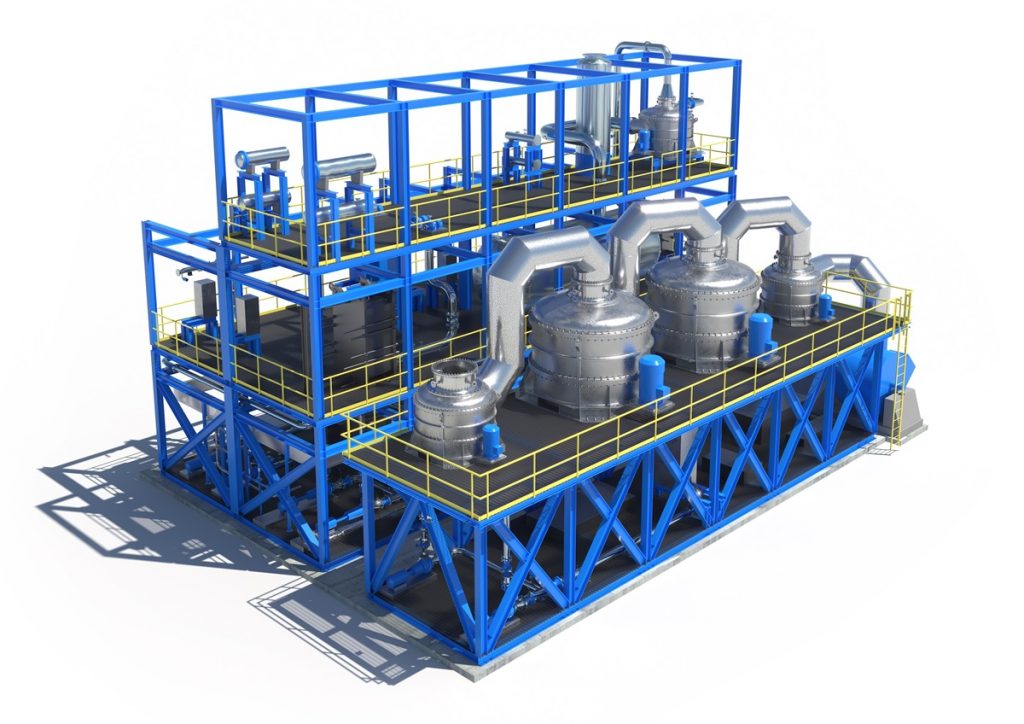Carbon Clean, a leader in revolutionising carbon capture solutions, announced the launch of its breakthrough CycloneCC C1 series, marking the penultimate stage in the technology’s commercialisation. The CycloneCC C1 series is available in concentrations ranging from 3% to 20%, capturing up to 100,000 tonnes of CO2 per year. The CycloneCC C1 unit is fully modular and columnless, achieving a height reduction of 70% compared to conventional solutions. Rotating Packed Bed (RPB) technology replaces every column used in a conventional plant, which reduces the steel required by 35% and lowers the unit’s carbon footprint.
The unit footprint is up to 50% smaller than conventional carbon capture plants, with its largest equipment sizes reduced by a factor of 10. Each unit is prefabricated, skid-mounted and delivered on road truckable modules, cutting the costs associated with transport, logistics, site preparation and installation. CycloneCC C1 uses first-of-a-kind (FOAK) technology to reduce the total installed cost of carbon capture by up to 50% compared to conventional solutions.
With the looming 2030 deadline for achieving a 45% reduction in global emissions, hard-to-abate industries are facing increasing pressure to decarbonise. However, more than 50% of industrial emitters lack the space required to deploy conventional carbon capture plants. With its space-efficient design, CycloneCC C1 offers a viable, cost-effective route to decarbonisation, particularly for small-to-midsize emitters. CycloneCC C1 is also ideal for emitters of all sizes looking to deploy carbon capture units across multiple flue gas emission sources.
Prateek Bumb, Co-founder and Chief Technology Officer of Carbon Clean, said: “The launch of the CycloneCC C1 series is a major milestone in the technology’s commercialisation. Repeatability is key to mass adoption, as demonstrated with solar panels and EV batteries. Carbon Clean is leading a similar transformation through eliminating the columns used in conventional carbon capture solutions. Delivering fully modular, columnless, replicable units with a substantially smaller footprint is a technological breakthrough. CycloneCC’s ‘Lego-block’, ‘plug and play’ design makes it simple and cost-effective to install, making carbon capture financially and logistically viable to be deployed at scale. First-mover customers and early adopters will have the advantage of tangible decarbonisation results while benefiting from a staggered approach to capital investment due to CycloneCC C1’s modular design.”
At the heart of CycloneCC C1 is the breakthrough combination of two process intensification technologies: rotating packed beds (RPBs) and Carbon Clean’s proprietary APBS-CDRMax solvent. The FOAK technology application of RPBs to a carbon capture plant is a gamechanger for the sector. Using RPBs to replace the columns used in conventional carbon capture solutions both reduces the size of the plant and accelerates the mass transfer process, increasing CO2 absorption.
Carbon Clean’s high-performing APBS-CDRMax solvent achieves substantial OpEx savings through outperforming the industry standard solvent. APBS-CDRMax lowers energy demand by 10-25%, reduces corrosion by a factor of 20, decreases degradation by a factor of 10, and has a lifespan that is five times longer than conventional solvents.
First-mover customers of the CycloneCC C1 series will have the opportunity to influence the development of the fully commercialised product while experiencing the benefits of tangible decarbonisation results. Early adopters will also be priority customers for the fully commercialised product when it is rolled out at scale.
Tags: Carbon Capture, Corbon Clean, Cyclonecc C1



Recent Posts
Scandlines Nears Delivery of Zero Emissions Ferry Following Successful Sea Trials
India faces emission roadblocks with rising net-zero demands
Green Energy Resources invests in two electric Liebherr LHM 550
NYK Launches Continuous Use of Bio LNG Fuel on Car Carriers to Advance Decarbonization Goals
Yang Ming Expands Fleet with Methanol and LNG Dual-Fuel Vessels Under Fleet Optimization Plan
ClassNK Advocates Speed Gap Monitoring to Optimize Fuel Efficiency in Heavy Weather
Wärtsilä’s retrofit package for the Corsica Linea ferry Pascal Paoli has resulted in fuel savings of up to 22 percent Corsica Linea
COSCO Shipping Names Second Methanol Dual-Fuel Containership in Yangzhou